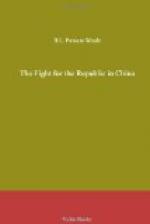The problem thus outlined becomes a great dramatic thing. The lines which trace the problem are immense, stretching from China to every shore bathed by the Pacific and then from there to the distant west. Whenever there is a dull calm, that calm must be treated solely as an intermission, an interval between the acts, a preparation for something more sensational than the last episode, but not as a permanent settlement which can only come by the methods we have indicated. For the Chinese question is no longer a local problem, but a great world-issue which statesmen must regulate by conferences in which universal principles will be vindicated if they wish permanently to eliminate what is almost the last remaining international powder-magazine. A China that is henceforth not only admitted to the family of nations on terms of equality but welcomed as a representative of Liberalism and a subscriber to all those sanctions on which the civilization of peace rests, will directly tend to adjust every other Asiatic problem and to prevent a recrudescence of those evil phenomena which are the enemies of progress and happiness. Is it too much to dream of such a consummation? We think not. It is to America and to England that China looks to rehabilitate herself and to make her Republic a reality. If they lend her their help, if they are consistent, there is still no reason why this democracy on the shores of the Yellow Sea should not be reinstated in the proud position it occupied twenty centuries ago, when it furnished the very silks which clothed the daughters of the Caesars.
APPENDIX
Documents in group I
(1) The so-called Nineteen Articles, being the grant made by the Throne after the outbreak of the Wuchang Rebellion in 1911 in a vain attempt to satisfy the nation.
(2) The Abdication Edicts issued on the 12th February, 1912, endorsing the establishment of the Republic.
(3) The terms of abdication, generally referred to as “The articles of Favourable Treatment,” in which special provision is made for the “rights” of Manchus, Mongols, Mohammedans and Tibetans, who are considered as being outside the Chinese nation.
The nineteen articles
1. The Ta-Ching Dynasty shall reign for ever.
2. The person of the Emperor shall be inviolable.
3. The power of the Emperor shall be limited by a Constitution.
4. The order of the succession shall be prescribed in the Constitution.
5. The Constitution shall be drawn up and adopted by the National Assembly, and promulgated by the Emperor.
6. The power of amending the Constitution belongs to Parliament.
7. The members of the Upper House shall be elected by the people from among those particularly eligible for the position.
8. Parliament shall select, and the Emperor shall appoint, the Premier, who will recommend the other members of the Cabinet, these also being appointed by the Emperor. The Imperial Princes shall be ineligible as Premier, Cabinet Ministers, or administrative heads of provinces.




